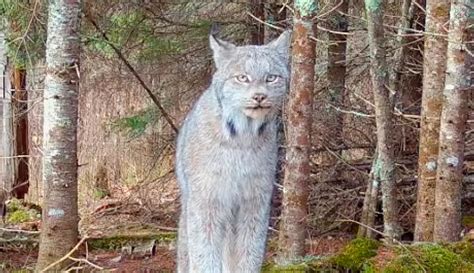
A remarkable sight has been captured on trail cameras in Utah: a large group of wolverines, a rare and elusive species, documented traveling together in what experts are calling an unprecedented encounter. The Utah Division of Wildlife Resources (DWR) confirmed the sighting, emphasizing its unusual nature given that wolverines are typically solitary animals.
The footage, captured on remote trail cameras, shows at least five wolverines moving through a snowy landscape. While the exact relationship between the animals remains unknown, their synchronized movement suggests a familial connection, possibly a mother and her offspring. DWR biologists are analyzing the footage to glean more insights into wolverine behavior and population dynamics in the region. This sighting is significant because wolverines are rarely seen in groups, making this event an exceptional opportunity for wildlife researchers.
The Utah DWR noted the rarity of such an observation. “It’s extremely rare to see five wolverines together like this,” said a spokesperson. “Wolverines are typically solitary animals, and sightings are uncommon, making this footage truly remarkable.”
Wolverines, known scientifically as Gulo gulo, are the largest members of the weasel family and are renowned for their strength, tenacity, and adaptability to harsh environments. They are primarily scavengers and opportunistic predators, feeding on carrion, small mammals, birds, and eggs. Their thick fur and large paws enable them to thrive in cold, snowy climates. Wolverines are found in alpine and subalpine regions of North America, Europe, and Asia, but their populations are generally sparse and fragmented due to habitat loss, human encroachment, and climate change.
Prior to this recent sighting, wolverine populations in Utah were considered extremely small. Confirmed sightings were infrequent, usually involving solitary individuals. The trail camera footage not only confirms the presence of a breeding group but also offers valuable data on their habitat use and social behavior. This data is vital for conservation efforts aimed at protecting wolverines and their habitat in Utah.
The DWR stated that it would continue to monitor the area where the wolverines were sighted, hoping to gain further insights into their activities. The cameras are part of a larger network used for wildlife monitoring throughout the state. These cameras play a critical role in tracking animal movements, assessing population trends, and informing management decisions.
The unexpected wolverine encounter underscores the importance of wildlife monitoring and conservation efforts in Utah. It also highlights the value of trail cameras as tools for documenting rare and elusive species. The DWR encourages the public to report any wolverine sightings, emphasizing that this information can contribute to a better understanding of these remarkable animals and their conservation needs.
The remarkable footage is now being widely shared online, sparking excitement among wildlife enthusiasts and conservationists. It serves as a reminder of the hidden wonders of nature and the importance of protecting these wild creatures for future generations. The sighting also emphasizes the ongoing need for research and monitoring to understand and conserve wolverine populations in the face of increasing environmental challenges.
Background Information and Conservation Status
Wolverines are an indicator species of healthy, intact ecosystems. Their presence reflects the overall health and resilience of the alpine and subalpine environments they inhabit. However, wolverine populations face numerous threats, including habitat fragmentation due to logging, mining, and recreational development; climate change, which reduces snowpack and affects their ability to hunt and den; and trapping, which can impact their survival rates.
In the contiguous United States, wolverine populations are relatively small and fragmented, with the largest concentrations found in the Rocky Mountains and the Pacific Northwest. Due to their low numbers and ongoing threats, wolverines have been the subject of conservation efforts for many years. The U.S. Fish and Wildlife Service has considered listing wolverines as a threatened or endangered species under the Endangered Species Act, but decisions have been delayed due to scientific uncertainties and political considerations.
The recent wolverine sighting in Utah underscores the importance of maintaining and restoring suitable habitat for these animals. Protecting critical areas from development, managing recreational activities to minimize disturbance, and reducing trapping pressure are all essential steps in ensuring their long-term survival. Climate change mitigation is also crucial, as wolverines depend on persistent snowpack for denning and hunting.
The Utah DWR has implemented several conservation measures aimed at protecting wolverines, including habitat assessments, population monitoring, and public education. The agency also works with landowners and other stakeholders to promote responsible land management practices that benefit wolverines and other wildlife species. The trail camera network plays a vital role in these efforts, providing valuable data on wolverine distribution, abundance, and behavior.
Analysis of Wolverine Social Behavior
Wolverines are generally considered solitary animals, with adults typically occupying large territories and avoiding close contact with others, except during the breeding season. Males and females maintain separate territories, with male territories often overlapping those of several females. Wolverines mark their territories with scent, using urine and anal gland secretions to communicate their presence and deter intruders.
During the breeding season, which typically occurs in late winter or early spring, males and females come together to mate. After a gestation period of about nine months, females give birth to litters of one to five kits in snow dens. The kits remain in the den for several months, relying on their mother for warmth, protection, and nourishment. As the kits grow older, they begin to explore the surrounding area and learn how to hunt and survive on their own.
The recent sighting of five wolverines traveling together raises questions about their social behavior. It is possible that the group consisted of a mother and her offspring, who were still dependent on her for care and guidance. Alternatively, the group may have been formed by related individuals who were cooperating to find food or defend their territory. Further research is needed to determine the exact nature of the relationship between these wolverines.
Implications for Wolverine Conservation
The wolverine sighting in Utah has several important implications for conservation efforts. First, it confirms that wolverines are still present in the state, despite their low numbers and elusive nature. Second, it suggests that there may be a breeding population of wolverines in the area, which is encouraging news for their long-term survival. Third, it highlights the value of trail cameras as tools for monitoring wolverine populations and gathering data on their behavior.
The information gathered from the trail camera footage can be used to inform management decisions and conservation strategies. For example, it can help identify critical habitat areas that need to be protected from development or other disturbances. It can also help assess the effectiveness of conservation measures that are already in place.
In addition to monitoring wolverine populations, it is also important to address the threats that they face, such as habitat loss, climate change, and trapping. This requires a collaborative effort involving government agencies, conservation organizations, landowners, and other stakeholders. By working together, it is possible to ensure that wolverines continue to thrive in Utah and other parts of their range.
The Role of Trail Cameras in Wildlife Monitoring
Trail cameras, also known as camera traps, have become an increasingly important tool for wildlife monitoring in recent years. These cameras are typically deployed in remote areas and programmed to take photos or videos when they detect motion or heat. They can be used to track animal movements, assess population trends, study behavior, and monitor the effectiveness of conservation efforts.
Trail cameras offer several advantages over traditional wildlife monitoring methods. They are relatively inexpensive, easy to deploy, and can operate unattended for extended periods of time. They also provide a non-invasive way to observe wildlife without disturbing their natural behavior.
The recent wolverine sighting in Utah underscores the value of trail cameras as tools for documenting rare and elusive species. Without the trail cameras, it is unlikely that the group of wolverines would have been detected. The footage captured by the cameras provides valuable data on their habitat use, social behavior, and population dynamics.
Expanded Context: Wolverine Distribution and Ecology
Wolverines occupy a vast range across the northern hemisphere, including parts of North America, Europe, and Asia. In North America, they are found in Alaska, Canada, and the northern United States, with populations concentrated in the Rocky Mountains, the Pacific Northwest, and the Great Lakes region. Wolverines are adapted to cold, snowy environments, typically inhabiting alpine and subalpine forests, tundra, and taiga.
Wolverines are opportunistic predators and scavengers, with a highly varied diet. They feed on carrion, small mammals, birds, eggs, and insects. They are also known to kill larger animals, such as deer, elk, and caribou, particularly when they are weakened by injury or illness. Wolverines have powerful jaws and teeth, which allow them to crush bones and consume frozen carcasses.
Wolverines play an important role in the ecosystems they inhabit. As scavengers, they help to remove carrion from the landscape, reducing the risk of disease transmission. As predators, they help to control populations of small mammals and other prey species. Their presence also indicates the health and integrity of the alpine and subalpine environments they inhabit.
The Impact of Climate Change on Wolverines
Climate change is a major threat to wolverine populations around the world. Wolverines depend on persistent snowpack for denning and hunting. As temperatures rise and snowpack decreases, wolverines are losing their habitat and their ability to find food.
Climate change is also affecting the distribution of wolverines. As their traditional habitat becomes unsuitable, they are being forced to move to higher elevations or further north in search of colder, snowier conditions. This can lead to increased competition with other species and reduced access to food and other resources.
Addressing the threat of climate change is essential for the long-term survival of wolverines. This requires reducing greenhouse gas emissions, protecting and restoring forests, and managing land in a way that promotes carbon sequestration. It also requires adapting to the changes that are already occurring, such as providing alternative denning sites and managing populations of prey species.
Public Engagement and Education
Public engagement and education are crucial for wolverine conservation. By raising awareness about these animals and the threats they face, it is possible to garner support for conservation efforts and promote responsible behavior. The Utah DWR encourages the public to report any wolverine sightings, emphasizing that this information can contribute to a better understanding of these remarkable animals and their conservation needs.
The DWR also provides educational materials about wolverines, including information about their ecology, behavior, and conservation status. These materials are available on the agency’s website and at visitor centers. The DWR also conducts outreach programs for schools and community groups, teaching people about wolverines and other wildlife species.
By engaging the public in wolverine conservation, it is possible to create a sense of stewardship and responsibility for these animals. This can lead to increased support for conservation efforts and a greater willingness to protect wolverine habitat.
The Future of Wolverines
The future of wolverines is uncertain. They face numerous threats, including habitat loss, climate change, and trapping. However, there are also reasons to be optimistic. Conservation efforts are underway in many parts of their range, and public awareness of these animals is growing.
The recent wolverine sighting in Utah is a reminder of the resilience of these animals and their ability to survive in challenging environments. It is also a reminder of the importance of continued research and monitoring to understand and conserve wolverine populations. By working together, it is possible to ensure that wolverines continue to thrive for generations to come.
Continued Monitoring and Research Needs
The DWR intends to continue closely monitoring the area where the wolverines were spotted. Additional camera traps may be deployed to gather more comprehensive data on the group’s movements, foraging habits, and interactions with other wildlife. Genetic analysis of scat samples, if obtainable, could help determine the familial relationships among the individuals and provide insights into the genetic diversity of the local wolverine population.
Further research is needed to understand the factors that influence wolverine distribution and abundance in Utah. This includes studying the impacts of climate change, habitat fragmentation, and human activities on their populations. It also includes investigating the potential for reintroduction or translocation of wolverines to areas where they have been extirpated.
Long-term monitoring is essential for tracking changes in wolverine populations over time and assessing the effectiveness of conservation measures. This requires a coordinated effort involving government agencies, conservation organizations, and researchers. By working together, it is possible to gather the information needed to make informed decisions about wolverine conservation.
Community Involvement and Citizen Science
The DWR emphasizes the importance of community involvement in wolverine conservation. Local residents and outdoor enthusiasts are encouraged to report any wolverine sightings, track observations, or other signs of their presence, such as tracks or scat. These reports can provide valuable data on wolverine distribution and behavior.
Citizen science programs can also play a role in wolverine monitoring. Volunteers can be trained to identify wolverine tracks and scat, deploy and maintain trail cameras, and collect other data. This can help to increase the amount of data that is collected and engage the public in conservation efforts.
By involving the community in wolverine conservation, it is possible to create a sense of shared responsibility for these animals. This can lead to increased support for conservation efforts and a greater willingness to protect wolverine habitat.
The Economic Value of Wolverines
Wolverines also have economic value. They contribute to the ecotourism industry, attracting visitors to areas where they can be observed in their natural habitat. They also play a role in maintaining healthy ecosystems, which provide valuable services such as clean water, clean air, and pollination.
By protecting wolverines, it is possible to enhance the economic value of these areas. This can create jobs, generate revenue, and improve the quality of life for local residents. It can also help to preserve the natural heritage of these areas for future generations.
The Cultural Significance of Wolverines
Wolverines hold cultural significance for many indigenous peoples in North America, Europe, and Asia. They are often revered as symbols of strength, resilience, and adaptability. They are also featured in traditional stories and ceremonies.
By protecting wolverines, it is possible to preserve these cultural traditions and honor the connections that indigenous peoples have with these animals. This can help to promote cultural diversity and understanding.
The discovery of the wolverine pack in Utah is not only a scientific find but also a cultural and environmental event, underscoring the need for continued conservation efforts and community engagement in protecting these magnificent creatures.
Frequently Asked Questions (FAQs) about the Wolverine Sighting
Q1: What makes the sighting of five wolverines together in Utah so unusual?
A: Wolverines are typically solitary animals, meaning they prefer to live and hunt alone. It is very rare to see multiple wolverines traveling together, especially in a group of five. This suggests a possible familial connection, such as a mother and her offspring, which is a significant observation for researchers. The DWR itself emphasized the rarity of seeing so many wolverines at once.
Q2: Where exactly in Utah was this wolverine pack filmed?
A: The exact location of the sighting has not been publicly disclosed by the Utah Division of Wildlife Resources (DWR). This is to protect the wolverines from potential disturbance or harm from human activity. The DWR is continuing to monitor the area.
Q3: What do wolverines eat, and how do they survive in harsh environments?
A: Wolverines are opportunistic predators and scavengers. Their diet includes carrion (dead animals), small mammals, birds, eggs, and insects. They are known for their ability to scavenge carcasses, even frozen ones. They survive in harsh environments due to their thick fur, which provides insulation against the cold, and their large paws, which act like snowshoes, helping them to move easily through deep snow.
Q4: Are wolverines endangered in Utah or the United States?
A: While wolverines are not currently listed as endangered, they are considered rare and vulnerable in the contiguous United States. The U.S. Fish and Wildlife Service has considered listing them as threatened under the Endangered Species Act, but the decision has been delayed. In Utah, wolverine populations are very small, and sightings are infrequent.
Q5: What can people do to help protect wolverines in Utah?
A: The Utah DWR encourages the public to report any wolverine sightings to help them monitor the population. Additionally, supporting conservation efforts, such as habitat protection and responsible land management practices, can contribute to the long-term survival of wolverines. It’s also crucial to minimize disturbance to their habitat by adhering to responsible outdoor recreation practices and supporting efforts to mitigate climate change, which threatens their snowy habitat.









